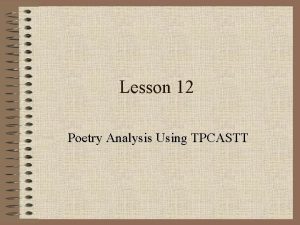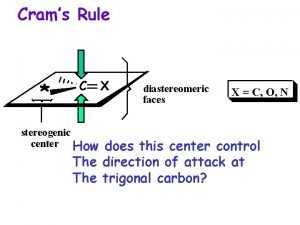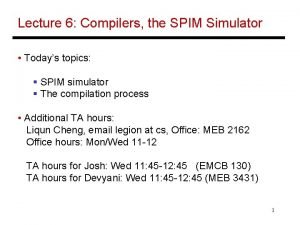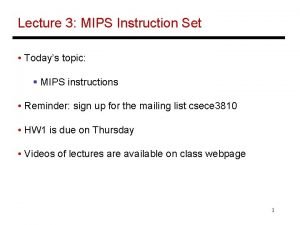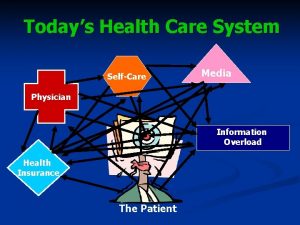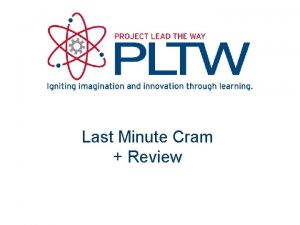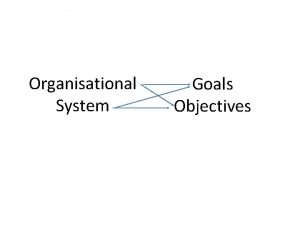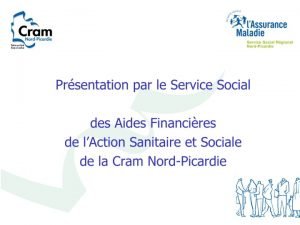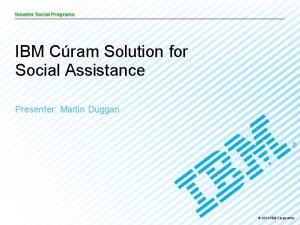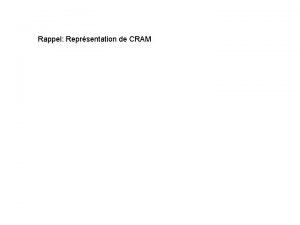Todays Agenda Goals of CRAM program Roles of


























- Slides: 26

Today’s Agenda • Goals of CRAM program – Roles of Teams – Need and Intended Uses • • • Summary of Science of Rapid Assessment Conceptual Model Development Process and Schedule Global/Programmatic Issues Next Steps

Features of Rapid Assessment • • Assess physical and biological condition Based on easy to evaluate field indicators Can be conducted rapidly Calibrated with field data Validated with more intense (level III) studies Applicable to a variety of wetland stream types Core set of indicators to assess “condition” + additional modules Ø mitigation success Ø water quality Ø endangered species • Iterative, ongoing process of development and refinement • Does not replace the need for detailed quantitative analysis

General Framework Climate, Geology, Land Use Supplies of Sediment &Water Fauna Flora

Assumptions of Rapid Assessment • Intent is to evaluate condition and stressors – assumes knowledge of relationship between stressors and their affect on condition • Assumes adequate knowledge about wetland ecology to identify and scale metrics • Uses readily visible physical and biological features as indicators of condition • Assumes that “condition” indicators reflect function at the site • Level III studies are necessary for validation

Sample Metrics from Other States

Ohio RAM Field Form Output: total score, stressor index, or rating category

Stressor Checklist - Sample

Today’s Agenda • Goals of CRAM program – Roles of Teams – Need and Intended Uses • • • Summary of Science of Rapid Assessment Conceptual Model Development Process and Schedule Global/Programmatic Issues Next Steps

Anticipated Uses of CRAM • Regional monitoring & assessment • Impact evaluation/stressor analysis • Alternatives analysis • Evaluation of restoration success • Mitigation compliance monitoring • Restoration siting & design • Assessing relative importance of wetlands in the watershed • Cumulative impact assessment

CRAM Conceptual Model Essential Indicators with broad, general applicability (core elements) These modify the core elements Universal Wetland Ecological Features: Biogeochemical properties Hydrology, Sediment Biotic communities Regional “filters” that determines wetlandscape profile Regional wetland types +characteristic functions Adjustments for successional stage Anthropogenic stressors that alter wetland condition Regionally refined indicators, including highly valued wetland types or features Report on wetland condition, by HGM class Validation with Level III site-specific data

CRAM Development • Method development • Field testing/calibration • Method refinement • Field validation (level III studies) • Peer review • Education and outreach

Selection of Metrics • Literature on wetland ecology and function • Other rapid assessment methods • Local studies and other data sources – – – peer-reviewed literature conference proceedings gray literature dissertations and thesis monitoring studies • Other assessment methodologies – HGM, IBI – stream bioassessment

Data Mining - sample Source Wetland Biological Features Physical Features Class Evaluated Peer- reviewed Page, 1997 estuary vascular plants, nutrients and invertebrates sediment yes SAWPA, 2002 riparian Watershed plan – numerous taxa no and physical features evaluated local data sources are being reviewed to help select and scale metrics

Categories of Metrics • • Size Buffer size, condition & adjacent land use Hydrology Habitat structure Vegetation/community structure Habitat alteration (stressor) Living resources (faunal) support Special/sensitive wetlands

Metric: Size • • • Size class 1: > 300 acres Size class 2: 50 -300 acres Size class 3: 25 -50 acres Size class 4: 3 -25 acres Size class 5: < 3 acres What are the appropriate size categories? Can one set of size categories pertain to different wetland classes (e. g. vernal pool vs. estuary)?

Metric: Buffer & Adjacent land use • Buffer width • Buffer condition • Land use condition and intensity outside of the buffer How should these metrics account for differences in widths or conditions on different sides of the wetland?

Metric: Hydrology • • Water source Water level fluctuations Duration of saturation/inundation Modification to site hydrology (stressor) Should the “stressor” metric be used as a modifier for the previous “condition” metrics, or evaluated separately with other stressor metrics?

Metric: Habitat Structure • Habitat development/quality • Structural and spatial diversity Is this one or two metrics? • Condition of Floodplain or contributing watershed Is this more appropriate in the hydrology category? How do we account for heterogeneous land use in the watershed? • Linear continuity of habitats • Habitat alteration Should the “stressor” metric be used as a modifier for the previous “condition” metrics, or evaluated separately with other stressor metrics?

Metric: Vegetation/community structure • Plant community composition • Interspersion • Invasive species coverage • Microtopographic complexity

Metric: Living Resource Support • Threatened and endangered species • Significant migratory songbird, waterfowl, or shorebird breeding, feeding, or roosting area. • Amphibian or reptile breeding or feeding area. • Anadromous fish breeding or migratory habitat

Metric: Special Wetlands • • • Vernal pool Wet meadow Tidal marsh Seeps and Springs (slope wetlands) Meromictic lagoons Regionally scarce wetlands

Today’s Agenda • Goals of CRAM program – Roles of Teams – Need and Intended Uses • • • Summary of Science of Rapid Assessment Conceptual Model Development Process and Schedule Global/Programmatic Issues Next Steps

Programmatic Questions • How rapid is “rapid” – what level of detail is possible? – how do we balance qualitative vs. quantitative metrics? • Are we assessing, opportunity, capacity or both? • How do we address different wetland classes – Robust metrics – Class-specific metrics – Focus on stressors only • How do we address seasonality, temporal variability, and successional stages?

Programmatic Questions (cont. ) • Do we focus on assessment of condition, stressors, or both? • Do we classify before or after we sample? – stratified sampling (verification) – random sampling (validation) • Should the method be mechanistic (i. e. algorithms) or descriptive (i. e. rule based)? • Should metrics be combined into an overall score or kept separate? • What is the role (if any) of reference sites?

CRAM Development Schedule Background research and development of the conceptual model Dec 02 – Jan 03 First regional review team workshop Feb 03 First draft CRAM Mar 03 Field testing April – May 03 Second regional review team workshop June 03 Second draft CRAM July 03 Second round field testing Aug- Sept 03 Third regional review team workshop Sept 03 Operational draft CRAM Oct 03

Next Steps 1. Choice of metrics 2. Incorporation of existing data sources 3. Calibration with new field data 4. Scaling of metrics 5. Validation and field testing Need to develop a strategy for method validation • Next iteration of method • Feb 19 -20 EPA workshop • Regional Team meeting • Next Core Team Meeting • Ongoing participation by Core Team
 Strategic goals tactical goals operational goals
Strategic goals tactical goals operational goals Strategic goals tactical goals operational goals
Strategic goals tactical goals operational goals Todays agenda
Todays agenda Ap physics cram sheet
Ap physics cram sheet Lecture to a missionary summary
Lecture to a missionary summary Cspan cram for the exam
Cspan cram for the exam Cram last minute
Cram last minute Ham cram
Ham cram Cram's rule
Cram's rule Agenda sistemica y agenda institucional
Agenda sistemica y agenda institucional General goals and specific goals
General goals and specific goals Motivation in consumer behaviour
Motivation in consumer behaviour Todays generations
Todays generations Today's class answers
Today's class answers Multiple choice comma quiz
Multiple choice comma quiz Todays worldld
Todays worldld What is todays temperature
What is todays temperature Todays globl
Todays globl Whats todays wordlw
Whats todays wordlw Chapter 13 marketing in today's world
Chapter 13 marketing in today's world Todays plan
Todays plan Todays sabbath lesson
Todays sabbath lesson Welcome to sabbath school
Welcome to sabbath school Midlands 2 west (north)
Midlands 2 west (north) Todays health
Todays health How to identify simile
How to identify simile Todays objective
Todays objective


